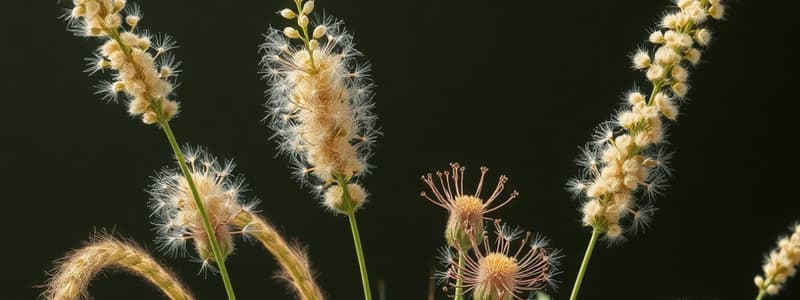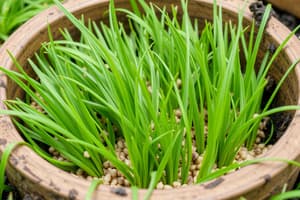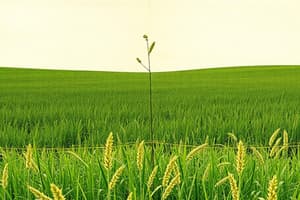Podcast
Questions and Answers
Match the following grass inflorescence types with their characteristics:
Match the following grass inflorescence types with their characteristics:
A = Spike B = Spicate raceme C = Raceme D = Open panicle
Match the following terms related to spikelets with their descriptions:
Match the following terms related to spikelets with their descriptions:
Pedicellate spikelet = Has a stalk Sessile spikelet = Attached directly to the rachis Peduncle = The stalk of a flower cluster Uppermost leaf = Leaf at the top of the inflorescence
Match the following inflorescence components with their corresponding illustrations:
Match the following inflorescence components with their corresponding illustrations:
Pedicellate spikelet = Represented in diagram A Sessile spikelet = Represented in diagram B Uppermost leaf = Represented in diagram C Peduncle = Represented in diagram D
Match the following descriptions to the correct inflorescence type:
Match the following descriptions to the correct inflorescence type:
Match the inflorescence types with their structural traits:
Match the inflorescence types with their structural traits:
Flashcards
Spike
Spike
A type of grass inflorescence where spikelets are attached directly to the main stalk, forming a compact, unbranched structure. Think of a wheat stalk.
Spicate Raceme
Spicate Raceme
A type of grass inflorescence with spikelets arranged on stalks (pedicels) along a central axis. Similar to a spike, but with a looser, less dense structure.
Raceme
Raceme
A type of grass inflorescence where spikelets are attached to stalks (pedicels) along a central axis, with the stalks being more elongated than in a spicate raceme.
Open Panicle
Open Panicle
Signup and view all the flashcards
Pedicel
Pedicel
Signup and view all the flashcards
Study Notes
Grass Plant Structure
- Grass plants have blades, sheaths, nodes, and spikelets.
- The culm is the stem of a grass plant.
- Rhizomes are horizontal stems, stolons are above ground horizontal stems, and fibrous roots are part of the root system.
- The blade, auricle, ligule, and sheath are components of the grass leaf.
Grass Inflorescence Types
- Spike: A spikelet is attached directly to the main axis.
- Spicate raceme: The spikelets are on pedicels
- Raceme: Spikelets are on pedicels along a central axis.
- Open panicle: A branching inflorescence with spicate branches.
- Specialized panicles: Alternate spicate primaries and digitate, subdigitate, and verticillate spicate primary unilateral branches.
Andropogoneae Inflorescences
- Paired spikelets at each node, including spicate racemes, subdigitate racemose branches, generally alternate branches, and an open panicle.
Spikelet Parts
- Spikelets have a rachilla, florets, awns, palea, stigma, anthers, lemma, ovary, lodicule, and floral axis.
- There are first and second glumes, reduced (neuter) florets, and pedicels. Each spikelet may have 6 or more florets.
Spikelet Parts - Genera and Tribes
- Diagrams of spikelets from specific genera.
- Spikelets represent specific species from Chlorideae, Eragrosteae, Paniceae, and Andropogoneae tribes.
Ligules of Grass Leaves
- Types of ligules: absent, ring of hairs, membranous, ciliate membrane, acuminate, obtuse, acute, truncate, entire, notched, and eorse.
Leaf Attachment and Plant Growth
- Sessile, petiolate, clasping, procumbent, erect, ascending, creeping, and decumbent.
Leaf Arrangement
- Opposite, alternate, and whorled.
Types of Forbs
- Types include acaulescent, caulescent, and horizontal stems, stolon, and rhizome are horizontal stems..
Leaf Types
- Simple (pinnate venation, parallel venation)
- Pinnately compound (3-foliate)
- Palmately compound (3-foliate, 9-foliate)
- Simple (scale-like, needles)
- Types also distinguished by odd even pinnately compound, bipinnately compound, and spine-like stipules.
Leaf Shapes
- Leaf shapes include deltoid, elliptic, linear, lanceolate, oblanceolate, oblong, orbiculate, obovate, ovate, sagittate, spatulate, and filiform.
Leaf Apices
- Leaf apices are characterized by terms like acuminate, acute, cleft, emarginate, obcordate, obtuse, apiculate, rounded, and truncate.
Leaf Margins
- Leaf margins exhibit variations such as ciliate, cleft, crenate, dentate, dissected, double serrate, entire, erose, incised, lobed, pinnatifid, serrate, sinuate, and undulate.
Inflorescence Types
- Spike, raceme, panicle, umbel, compound umbel, cyme, corymb, compound cyme, catkin, and head.
Flower Types
- Flower types include zygomorphic (papilionaceous), zygomorphic, actinomorphic (without petals), actinomorphic (with petals), head (inflorescence type not a single flower).
Asteraceae Head Types
- Head types like radiate, ray flower, disk flower, discoid, receptacle, and vertical sections of radiate ligulate.
Fruit Types
- Fruit types included are fleshy (berry, accessory, drupe), and dry indehiscent (nutlet, achenes).
Dry Dehiscent Fruits
- Follicle, capsule, urticle, silicle (capsule), silique (capsule), loment, legume (coiled) and legume are dry dehiscent fruits.
Studying That Suits You
Use AI to generate personalized quizzes and flashcards to suit your learning preferences.




